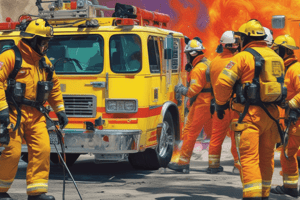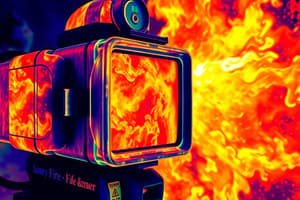Podcast
Questions and Answers
What is the concept discussed for the detection of missing persons' cadaveric remains using Thermal Imaging?
What is the concept discussed for the detection of missing persons' cadaveric remains using Thermal Imaging?
Detection using Thermal Imaging (TI) is a relatively new concept.
What are some challenges mentioned regarding thermographic image in medical applications?
What are some challenges mentioned regarding thermographic image in medical applications?
- Difficulty in detecting heat signatures.
- Cost of new equipment. (correct)
- Limited usefulness in later stages of missing person's searches.
- Potential retractions of resources during the search.
Thermal Imaging cameras are widely used by fire departments during all stages of search and rescue missions.
Thermal Imaging cameras are widely used by fire departments during all stages of search and rescue missions.
False (B)
Thermal imaging works best in _____ conditions.
Thermal imaging works best in _____ conditions.
Match the following applications of Thermal Imaging with their use:
Match the following applications of Thermal Imaging with their use:
What are the 6 stages of decomposition that cadavers go through?
What are the 6 stages of decomposition that cadavers go through?
Which insect species are typically the first to arrive at cadaveric remains?
Which insect species are typically the first to arrive at cadaveric remains?
Insect larvae masses can maintain temperatures above ambient levels.
Insect larvae masses can maintain temperatures above ambient levels.
At an ambient temperature of 70°F, fly larvae will hatch within __ hours.
At an ambient temperature of 70°F, fly larvae will hatch within __ hours.
Match the stages of fly larvae growth with their corresponding durations:
Match the stages of fly larvae growth with their corresponding durations:
Flashcards are hidden until you start studying
Study Notes
Thermal Imaging Cameras in the Detection of Human Cadaveric Remains
Introduction
- Thermal imaging (TI) has been used in various fields, but its application in forensic anthropology is a relatively new concept.
- TI can be used to detect human cadaveric remains in missing person searches, especially in later stages when the hope of finding the person alive has diminished.
Thermal Imaging
- All objects above absolute zero temperature emit infrared energy, which can be detected by thermal imaging cameras.
- Thermal imaging cameras view warmer objects as white and cooler objects as shades of gray or color.
- The first infrared sensitive cameras were developed in 1929, and the technology has evolved over the years to become more accessible and affordable.
Missing Persons Searches
- Many firefighters are members of Search and Rescue teams, which use thermal imaging cameras to locate missing individuals.
- Search and Rescue teams consist of an emergency manager, department heads, and emergency responders, each with unique specializations.
- The emergency manager decides on the size and duration of the search, as well as when to transition from a rescue to a recovery mission.
Decomposition
- Cadavers go through six stages of decomposition: fresh, bloat, active decay, advanced decay, dry, and remains.
- During the fresh stage, cadavers undergo algor mortis, a reduction in core body temperature.
- Insect colonization and decomposition processes cause an increase in heat signatures, which can be detected by thermal imaging cameras.
Entomology
- Blowflies are typically the first insect species to arrive at cadaveric remains, and they lay eggs in the eyes, body orifices, and open wounds.
- Fly larvae go through three instars, consuming the carcass and producing heat as they grow.
- Beetles are the last to leave the cadaver, feeding on fly larvae.
Use of Thermal Imaging
- Thermal imaging cameras can detect heat signatures from insect colonization and decomposition.
- The optimal time frame for a TI search depends on the temperature, size, and health of the individual.
- Injuries, size, and health of the individual will dictate the timeframes of not only the duration of the search and rescue but also the length of time and intensity of the colonization and detection by TI.### UAV and Thermal Imaging (TI) in Forensic Searches
- Early morning hours were thought to provide the greatest temperature difference between decompositional heat signatures and environmental temperatures, but this theory has been disputed.
- Current studies have shown that heat signatures detected by TI are not solely due to decomposition, but also include larval masses (DesMarais, 2014; Pearson, 2014; Heaton, Moffatt, & Simmons, 2014).
TI Limitations and Ideal Timeframes
- Early morning TI use is not recommended in colder climates during cooler months due to significant temperature cooling overnight and larval masses converging to inner cavities.
- Mid-morning to early afternoon TI use is less ideal, but extends search time parameters and allows for safer traversing conditions.
- Daytime imaging can be challenging due to objects absorbing radiant energy, causing confusion with larval mass heat signatures (Woodworth, 1997).
- Experienced staff can handle TI and ambient signatures during the day, but new users should avoid peak midday temperatures for a few hours afterward.
- The ideal timeframe for TI search is late afternoon/early evening into the early evening, when larval thermal emissions contrast sharply with surroundings.
- Heavily shaded locations exhibit less radiant energy, allowing for greater larval temperature differentiation and extending the search timeframe to include most of the day and early evening.
Seasonal Factors
- Larval activity is dictated by seasonal temperatures, with temperatures that are too high (>104°F) or too low (<32°F) affecting TI effectiveness.
- Seasonal temperatures impact the optimum ability of TI to differentiate larval mass heat signatures from surroundings.
Studying That Suits You
Use AI to generate personalized quizzes and flashcards to suit your learning preferences.




